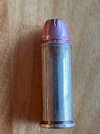coondogger
Member
- Joined
- Aug 18, 2009
- Messages
- 552
I've been loading some 44 spl. It's a plain Jane recipe; 6.7g Unique and a 200gr jacketed projectile. The OAL for this round is listed as 1.495. But I was getting damaged cases when seating the bullet. So I expanded it a bit more. Which made me think I should crimp it a half turn more. Which seated the bullet deeper. So the OAL is now 1.485. I'm wondering if this will make the pressure too high. I've only loaded five like this so maybe I'll just take them apart and seat the bullets for the rest at 1.505. Hmmm. Any opinions on this?


